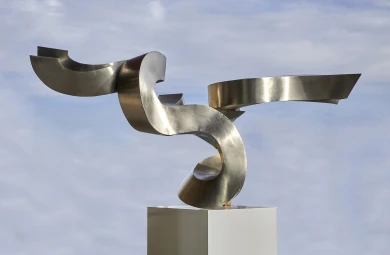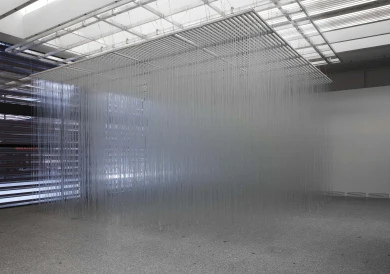
Vigilante rojo (Red Watchman)
- Technique
- Painted aluminium sheet metal
- Dimensions
- 182 x 222 x 163 cm
- Year of entry
- 1988
- Registration number
- AS07726
- Date
1979
- Credit
Donation of the author, 1983
Edgar Negret came together with Jorge Oteiza in Popayán between 1944 and 1946, with the Basque sculptor sharing his knowledge on Henry Moore and on the void as a dialectic opposite of the solid, and as an elemental task of conciliation and synthesis in the sculptor. Oteiza greatly admired Negret’s work: “Not because he is the most important sculptor in Latin America and one of the pre-eminent sculptors in contemporary sculpture, but because of the laminate nature of his sculptures, the personal production of his language, the capacity of his laminate structures to articulate and penetrate in the physical heights of the great symbolic and open spaces” (1980).
His style of maturity is based on a sculpture-action which lays bare the nuts and bolts, an assembly which unearths the operation of organising bodies and connections. His eye-pleasing welded components are covered by a uniform layer of industrial matte paints — red, generally speaking — which eradicates the pictorial visuality of metal as it bestows on it a machine-like quality.
The Watchmen series is among the most emblematic in his body of work, with a large-scale version presiding at the parade ground of the Palacio Presidencial de Nariño in Bogotá since 1978. Thus, Vigilante rojo (Red Watchman) comprises ten columned elements in a parabolic motion. Each of the vertical pieces turns thirty degrees in relation to the previous one, giving rise to five counterposed twin structures. Its deployment is an invitation to traverse the kinetic sequence experienced upon moving around the structure.
Negret had been an admirer of the plastic and colourful architecture of Antoni Gaudí since his first trip to Spain in 1953: Vigilante rojo refers to the warriors in the chimneys of Casa Milá in Barcelona. In fact, he defined his sculptures as “inefficient instruments to escape”.
Manuel Segade

